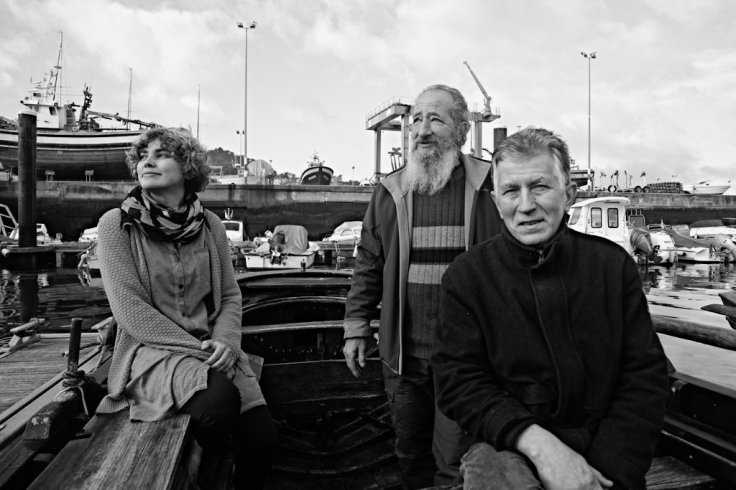“I went to sail with Víctor, and I fell totally in love with it – I said to myself, “this is marvellous!” – and it was a day in which there was a very soft breeze, and the boat it moved, but slowly, it was all super peaceful, and how marvellous, no? The silence, going about through the water, without the motor grinding eeeeerrgh, it seemed to me so good…” – that is how Lidia describes her love-at-first-sail experience with the traditional boats of Bueu, a marinero town on the north-facing peninsula of Morrazo, Galicia.
Remembering this, her voice is made soft by what in Spanish they call ilusión, that eager energy, emotion, or state of being that makes you wide-eyed. “I must go down to the seas again”, she might say, “for the call of the running tide”, as John Masefield wrote in his poem Sea Fever, “is a wild call and a clear call that may not be denied; And all I ask is a windy day with the white clouds flying, And the flung spray and the blown spume, and the sea-gulls crying…”

Lidia forms part of Os Galos, an association dedicated to maintaining the art and practise of traditional seafaring in this part of the world where maritime culture permeates through all, through commerce, family, and identity. A century ago the harbours of Galicia’s sparkling Rías Baixas were dotted with autochthonous sailing boats fluttering about to capture fish, deliver goods, and harvest seafood.
“…Now young people don’t navigate by boat, they navigate on the internet”
– Víctor
There was a boat for every trade – the polbeiro for octopus hunting, the traiñera for sardine fishing, the galeón for transport, the gamela for support roles, and the beautiful dorna, a boat built for all of the above and more. The dorna is the Galician vessel par excellence; a sturdy but manoeuvrable boat whose origins can be traced back to the Celtic cultures of old which populated the bays and harbours of Galicia. “Oh, if I could have any boat…It’d be a dorna…!” an acquaintance wishes to himself, his eyes imagining himself sat in the little dorna, where the water flows a foot below you. Whoever here speaks of the dorna seems to speak with that ilusión and that wide-eyed look.

These boats survived even the arrival of the steam engine in the early twentieth century, and it was not until the second half of the twentieth century when the combustion motor would make them a largely redundant craft. Were it not for the voluntary work of associations like Os Galos, these vessels would be extinct species. After years of construction and restoration work, Ol Galos “Now has a very large patrimony”, tells me Víctor – one of the founding fathers of the Galos – who has seen that “many things are lost for not valuing them enough”.
Lives and Times…
Feeling the Sea Fever? Read Death of a Whaling Industry, another Lives and Times chapter on man’s relation with the sea.
….Writing on the World Around Us
In Bueu a lot has already been lost, above all industry, but the association has fought for the preservation of the old shipyards which are now under protection of the local Massó Museum. Were it not for the insistence of Os Galos, probably these shipyards would have been torn down to make way for new flats, cafés, or an extended maritime boulevard. Samuel, a man who has been sailing since he was a twelve year old boy, puts it this way: “if you don’t know where you come from, you don’t know where you’re going.”

But Samuel, Víctor, and Lidia all worry about the future, recognising that it is difficult to attract younger people to the cause. Víctor’s baritone voice muses: “La gente joven no navegan por barco, navegan por internet”: young people don’t navigate by boat, they navigate the net. Samuel recognises that at sea “everything is difficult. You’re isolated, imagine: put yourself in on an island, limited, of a few metres, and you’re there for twenty-four hours”: that is how it was for him, a life spent at sea – working on offshore platforms, fishing on high seas and low – migrating north and south, east and west, himself a Galo, a sea bird following the sources of sustenance the sea offers.

Now though, the sea is but pure pleasure for Samuel and his companions. “I must go down to the seas again” they might say, “to the lonely sea and sky” as John Masefield wrote in his poem Sea Fever, “and all I ask is a tall ship and a star to steer her by; and the wheel’s kick and the wind’s song and the white sail’s shaking, And a grey mist on the sea’s face, and a grey dawn breaking…”
Lives and Times…
For more from land and sea, subscribe here…
Writing on the World Around Us…


Reblogged this on Cleaning Service in the Stockholm.
LikeLike